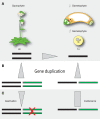When Double is not Twice as Much
- PMID: 22645557
- PMCID: PMC3355729
- DOI: 10.3389/fpls.2011.00094
When Double is not Twice as Much
Abstract
Gene and genome duplications provide a playground for various selective pressures and contribute significantly to genome complexity. It is assumed that the genomes of all major eukaryotic lineages possess duplicated regions that result from gene and genome duplication. There is evidence that the model plant Arabidopsis has been subjected to at least three whole-genome duplication events over the last 150-200 million years. As a result, many cellular processes are governed by redundantly acting gene families. Plants pass through two distinct life phases with a haploid gametophytic alternating with a diploid sporophytic generation. This ontogenetic difference in gene copy number has important implications for the outcome of deleterious mutations, which are masked by the second gene copy in diploid systems but expressed in a dominant fashion in haploid organisms. As a consequence, maintaining the activity of duplicated genes might be particularly advantageous during the haploid gametophytic generation. Here, we describe the distinctive features associated with the alteration of generations and discuss how activity profiles of duplicated genes might get modulated in a life phase dependent fashion.
Keywords: alternation of generations; diploid; flowering plants; gene duplication; haploid.
Figures


Similar articles
-
Transcriptomic evidence for the evolution of shoot meristem function in sporophyte-dominant land plants through concerted selection of ancestral gametophytic and sporophytic genetic programs.Mol Biol Evol. 2015 Feb;32(2):355-67. doi: 10.1093/molbev/msu303. Epub 2014 Nov 4. Mol Biol Evol. 2015. PMID: 25371433
-
Molecular Control of Sporophyte-Gametophyte Ontogeny and Transition in Plants.Front Plant Sci. 2022 Jan 13;12:789789. doi: 10.3389/fpls.2021.789789. eCollection 2021. Front Plant Sci. 2022. PMID: 35095963 Free PMC article. Review.
-
Dating and functional characterization of duplicated genes in the apple (Malus domestica Borkh.) by analyzing EST data.BMC Plant Biol. 2010 May 14;10:87. doi: 10.1186/1471-2229-10-87. BMC Plant Biol. 2010. PMID: 20470375 Free PMC article.
-
How MIKC* MADS-box genes originated and evidence for their conserved function throughout the evolution of vascular plant gametophytes.Mol Biol Evol. 2012 Jan;29(1):293-302. doi: 10.1093/molbev/msr200. Epub 2011 Aug 3. Mol Biol Evol. 2012. PMID: 21813465
-
Cross talk between the sporophyte and the megagametophyte during ovule development.Sex Plant Reprod. 2011 Jun;24(2):113-21. doi: 10.1007/s00497-011-0162-3. Epub 2011 Feb 5. Sex Plant Reprod. 2011. PMID: 21298290 Review.
References
-
- Autran D., Baroux C., Raissig M. T., Lenormand T., Wittig M., Grob S., Steimer A., Barann M., Klostermeier U. C., Leblanc O., Vielle-Calzada J. P., Rosenstiel P., Grimanelli D., Grossniklaus U. (2011). Maternal epigenetic pathways control parental contributions to Arabidopsis early embryogenesis. Cell 145, 707–71910.1016/j.cell.2011.04.014 - DOI - PubMed
LinkOut - more resources
Full Text Sources
Research Materials

